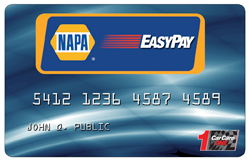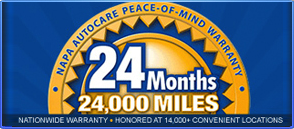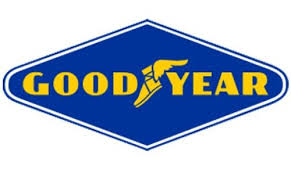Car Care
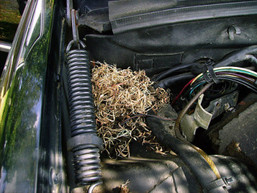
Car Critters
Cold nights and chilly mornings….. makes us think of warm coffee and snuggling under a blanket. Unfortunately, we are not the only ones looking for some heat. Animals- mice, squirrels, chipmunks, and even snakes or stray kittens– are looking for a place to keep warm. And the inside of your car, specifically your engine, is a perfect spot for them to make their cold-weather home.
Animals in your car can be more than just annoying; they can cause real damage. The problem most often is seen is chewing through wires (mice and squirrels gnaw on things to grind down their constantly growing teeth). But the damage can affect just about any part of your vehicle: animals will chew through or shred (to make nests) plastic fluid containers, under-the-hood insulation, air filters, storage area carpeting, and even seat cushions.
Symptoms of a vehicle with an “extra passenger” include a signs of animal droppings, twigs, leaves or other unusual material under the hood or around the car. Often, the “check engine” light or an odd odor raises the flag. A nest under the hood can choke out the engine. If the creature has started to gnaw on your electrical system or hoses, the car may not start or have other obvious mechanical problems.
Removal of the animal and its nest can be messy, especially if the creature is still in the vehicle (and worse, if it has died). Repairs necessary due to rodent damage can reach into the thousands of dollars. SOMETIMES repairs are covered by the comprehensive part of your insurance, but it varies by company. This is definitely a case where “an ounce of prevention equals a pound of cure.”
One of the easiest ways to keep animals out of your vehicle is to make it “distasteful” — do not leave food, food wrappings, or sweet smelling air fresheners in the car. Plug up any openings (rusted through spots, holes in convertible rag tops). “Home made” preventive measures that have been tried with varying success include rat poison in the trunk area, mothballs, peppermint oil (mice supposedly do not like the smell), and dryer sheets. There are also several commercial products on the market.
Wildlife is a wonderful thing to experience, but only when it is OUTSIDE of your vehicle!
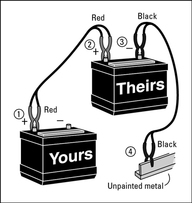
A Safe Jump Start
With families on the road with summer vacations, college students on their way back to campus, and school carpools starting, the season of dead batteries is not limited to cold weather months. And with the variety of ignition/ engine systems available now, jump starting a dead battery is not the simple procedure is used to be.
Each time you turn on the key of your car, it pulls on the battery. If you are only making short trips in your car (errand running around town, etc) or you don’t drive your car on a regular basis, your car does not have time to recharge the battery. You can help your battery by making a longer trip (30 minutes or more) periodically so that it can build up charge. If this is not something you are interested in doing, you may purchase a device called a trickle charger. This item is attached to your battery (they even have solar ones) to “gently” charge your battery and prevent it from dying from non-use.
If you find yourself behind the wheel of a dead battery, you will need a jump start to get you on your way. WARNING: IF YOUR VEHICLE (OR THE JUMPING VEHICLE) HAS AN ELECTRIC IGNITION (PUSH BUTTON) OR USES ALTERNATE FUEL (EX: HYBRIDS), JUMP STARTING MAY DAMAGE THE VEHICLE.
To safely jump a start, follow these steps
- Take out your jumper cables. It’s a good idea to buy a set of jumper cables and keep them in the trunk compartment. If you don’t have jumper cables, you have to find a good Samaritan who not only is willing to assist you but who has jumper cables as well.
- Place both vehicles in Park or Neutral and shut off the ignition in both cars. Engage both parking brakes as well.
- Attach one of the red clips to the positive terminal of your battery. It has “POS” or “+” on it, or it’s bigger than the negative terminal.
- Attach the other red clip to the positive terminal of the other car. Attach one of the black clips to the negative terminal on the other battery.
- Attach the last black clip to an unpainted metal surface on your car that isn’t near the battery .Use one of the metal struts that holds the hood open. The cables should look like this.
- Make sure to connect jumper cables in the proper order.
- Try to start your vehicle.
- If it won’t start, make sure that the cables are properly connected and have the good Samaritan run his or her engine for five minutes. Then try to start your car again. If it still won’t start, your battery may be beyond help
If the jump works and your car starts, don’t shut off your engine! Drive around for at least 15 minutes to recharge your battery. If the car won’t start the next time you use it, the battery isn’t holding a charge and needs to be replaced.
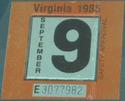
Your Pre-Inspection Inspection
If you live in one of the many states that require an annual state inspection, it is probably equal on your “fun list” as a trip to the dentist. But, just like that dental check-up, a vehicle inspection can be a valuable way to insure that everything is working like it should. It is also a way to be alerted to those things that may be unsafe (and could earn you a ticket). To make your inspection trip less painful and less costly, there are several things you can inspect (and repair, if needed) before you arrive at the shop.
- windows- the driver’s window must be in working order
- windshield wipers- the front wipers must work and not be ripped/ torn
- all lights (including the third brake light in the middle of the back window) must work
- horn volume (should be audible for 200 ft)
- both front doors must open from the inside and the outside
- emergency brake must work (engage the parking brake- put the vehicle in drive and let off the brake pedal- does the vehicle move?)
- headlights- their aim should align and work for both bright and dim settings
- tire tread- is it time for new tires?
- rear license plate- must be easily visible
- hood- does it latch?
- seat belts- all seat belts must be installed and working
Obviously, there is more to a vehicle inspection than what is listed above: brakes, steering, fuel, suspension, exhaust, fluids, air bag system, etc. Some of these are things that can be easily fixed in your own garage, while others may require a pre-inspection trip to your mechanic. Regardless of how you take care of any problems, a car that is in good working order will make your inspection visit quicker, easier, and less-stressful.
( These standards are summarized from the Virginia State Police Safety Inspection Program. Residents of certain localities in Virginia have additional emissions standards. You should check the requirements in your state/ locality)

On Your mark, get set,…. ACHOO!
Winter is finally over (at least that is what the calendar says). The signs of Spring are all around: grass coming up, flowers blooming, the breeze blowing, and more time outside. Oh yeah, I almost forgot these signs of Spring: tissues, red eyes, and a yellow film of pollen EVERYWHERE. Whether you live in Virginia(which is one of the top ten states for allergies) or elsewhere, ragweed, tree pollen, blooming plants, and all those beautiful looking pieces of nature can keep us from enjoying time outside.
These allergens can also get to us in our car. When you use your air conditioner, heater, etc., air is pulled from outside into your car’s cabin, including whatever allergen is in the air. Your car’s cabin air filter is responsible for keeping these irritants from coming through the vents. When this filter is clogged with pollutants (natural or man-made), it prevents the filter from, well, filtering. “A dirty or clogged cabin air filter can cause contaminants to become so concentrated in the cabin that passengers actually breathe in more fumes and particles when riding in the car than when walking down the street,” said Rich White, executive director, Car Care Council.
Your owner’s manual contains a recommended preventive maintenance schedule that includes when to replace the cabin air filter (usually every 12,000 to 15,000 miles). This is not a filter that can be cleaned and reinstalled; it needs to be replaced. The filter is part of the HVAC housing and is either accessed under the hood or through the interior/ dash area.
Spring allergies can cause those who suffer a string of annoying symptoms: itchy eyes, runny or stopped up sinuses, and a general feeling that you are walking in a fog. Sometimes they are bad enough to require a visit to a physician, a pharmacy or, in the least, staying inside. Taking care of the air filter in your car can prevent these symptoms from following you into your car.
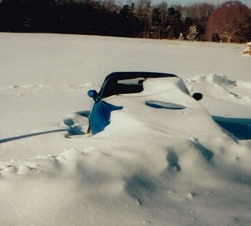
Another Blog Post about Snow
By the end of January in Virginia, most of us are either done with Winter weather or disappointed at the lack of it. Regardless of what may (or may not be) falling from the sky, the media makes us all afraid to go outside without “prepping” our car. But what do we REALLY need to be safe while driving this time of year?
- clean headlights: not only for weather purposes, but because it is prime deer season! It seems that every year, almost as many deer are taken out by vehicles as by hunting clubs. Having clear and clean headlights will allow you to see any animals approaching the ditch line. Remember: they don’t understand right-of-way laws!
- properly inflated tires: Tire pressure goes down with the temperatures. Under inflated tires affect breaking distance on wet surfaces and steering ability. Tires with too-low pressure also are more prone to blow-outs, creating danger for you and for others on the road.
- a good ice scraper and working wipers: An ice scraper (or windshield cover) is a necessity during a wet winter when frost/ freezing is expected. Your car’s defroster cannot usually get all of the frost/ ice from your car’s windows- and ALL windows need to be clear to allow for proper visibility. Once you get driving, windshield wipers that are in good condition make a great difference in seeing. Wipers that are not flush with the windshield or that are partially dry-rotted will leave streaks that will refreeze.
- windshield wiper fluid: In the winter, wiper fluid is necessary to remove the spray and chemicals that fly up from other vehicles. Make sure it is NOT water in the reservoir (that will obviously freeze) and that the fluid nozzles are clear.
- working KEY locks: Colder weather is harder on car batteries. If your battery isn’t working, neither will your electric lock. Keep your key lock lubricated (some of the DIY sites recommend a little bit of cooking oil on the lock) and run your key through it periodically.
And as all the “winter weather” sites say, it is a good idea to keep a blanket/ coat, a stand-alone phone charger, and all those other “just in case” items in a bag/ container in your vehicle. Or better yet, stay at home during the rough weather and order take-out!
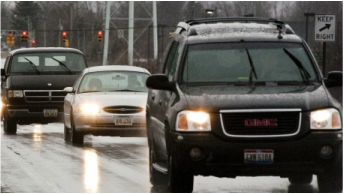
To See and to be seen…
With fewer hours of daylight (and the prediction of a wet winter), properly working headlights and windshield wipers have become especially important. Seeing where we’re driving and being seen by others on the road is not only a matter of safety for ourselves, but a possible invitation for a ticket. Lack of headlight use or defective headlights are both cause for police to issue a traffic violation. (Code of Virginia 46.2 -1030)
There are several things that can be done in your own driveway to make sure your headlights and wipers are in good working condition:
- make sure your headlights, turn signals, and brake lights work. Often, a neighbor or friend will notice it, but not always. Enlist a family member to “take a look” when you are leaving or coming home.
- keep your headlights free of dirt and bugs- it doesn’t take much to block out brightness.
- periodically wipe clean your wipers- small bits of debris (leaves, bugs, etc) can interfere with a “clean sweep” of your wipers in inclement weather.
- Don’t forget your back window wiper (if you have one)- wipers deteriorate whether they are used or not, and back window wipers are not part of Virginia’s Vehicle Inspection. They can go bad and you won’t know it until the snow is falling and you need them!
Headlights that are older can be repaired instead of replaced to improve their effectiveness. This service is available at A. C. Tire. We also carry a range of wipers- and yes, there is a difference in wipers! For other tips on maintaining your headlights and wipers, check this article from CarCare.org
Getting ready for winter
Most families in Virginia have finally accepted that Summer is indeed over. With the falling temperatures and the falling leaves, it is time to take down the picnic umbrellas, store the outdoor furniture cushions and put away the lawnmower and the weed whacker. As you prepare yourself and your home for the cooler days, don’t forget about your car. October is Fall Car Care Month and, just like remembering to check your smoke alarm when the time changes, it is a good idea to check some things on your car before October is over.
- Is your spare tire in working condition? (Is it even still there?) Having a flat tire is awful enough- not having a functioning spare tire (or not having a spare at all) makes it even worse, especially in cold or rainy weather.
- Are your wipers in working order? We have had our share of rain (despite what the meteorologists say), and your wipes may be a bit worn. Worn or “floppy” wipers are NO FUN in ice and snow.
- Check your washer fluid! The pollen and leaves that fall leave a coating of dust on your windshield that is not only irritating, but can affect the clarity of your windshield, especially with oncoming headlights. And talk to your mechanic about additives to include in your washer fluid to help with de-icing- it sure beats using a scraper!
- Consider what you are carrying in your car- you don’t need that folding chair or beach bag anymore, but an extra blanket, bottled water, and jumper cables might come in handy.
For more information on how to get your car ready for the changing seasons, go to The Car Care Guide, published by carcare.org to view online or order a free copy.
What do the numbers on the side of your tire mean?
Whenever you come into a tire shop and ask about purchasing tires, the tire specialist is going to ask you, “What size do you need?” or “What kind of tires do you have?” Instead of answering, “Round” or “whatever fits my car,” pay attention to what is on the sidewall and what it means. Not only will this make your conversation more efficient, it will protect you from being sold something that might be in stock and a good price, but isn’t meant for your car. The quick translation:
- The first letter (usually a P or LT) stands for the kind of vehicle- (Passenger, Light Truck)
- The next set of numbers (185, 215, etc.) tells the tire width (measured in millimeters) from sidewall to sidewall
- The number after the / (65, 70 etc.) is the aspect ratio (a mathematical ratio involving the height of a tire’s cross-section to its width)
- The next letter (usually a R) means it is a radial tire (the layers run radially across the tire
- The last number (in most tires) is the wheel diameter. Most cars run somewhere between 13-18; trucks can be 20+









